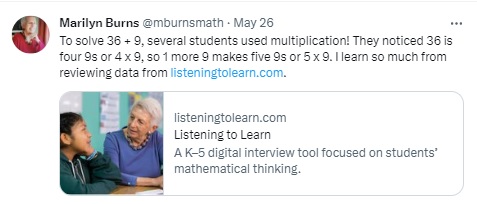I’m thrilled that number talks have been embraced by so many teachers. I love using number talks for many reasons. Here are just some of them:
- Number talks are an engaging and useful way to begin math class.
- They give the students opportunities to explain their thinking and they give me a chance to focus on how the students are reasoning.
- Number talks can serve a variety of purposes, including introducing something new for students to think about, focusing on an idea that we recently explored to reinforce, revisiting math ideas they’ve experienced earlier, and more.
- Recording students’ ideas on the board helps me focus on how they reasoned, not on how I was hoping they might reason.
- Recording students’ ideas models for the class how I represent their ideas mathematically.
- When I record a student’s thinking, others have the chance both to hear and see the idea, and I find this is especially helpful for some students. (It is for me, too.)
I could continue the list, but what’s on my mind now are the similarities and differences between number talks and lessons. Yes, number talks are typically designed to take less time and usually are used as openers to math lessons. In contrast, math lessons typically take longer, a class period or even more, and use a variety of structures to give students experiences that help them make sense of math. Lessons rely on a blend of experiences designed to give access to math concepts, patterns, properties, and skills, and more ―investigations for students, often using manipulative materials, small group problem solving, teacher explanations, individual assignments, games, practice, etc.
Pedagogy for Lesson Talks and Lessons
The bedrock of my pedagogy is similar for both. I focus on listening to students’ thinking and I use their ideas to inform my instructional moves. Making students’ thinking the starting point and the inspiration when teaching has probably been the biggest change to my teaching practice over the years. I plan lessons thoroughly and think through, as carefully as I can, how to structure all aspects of the experience. I find that detailed planning is essential for me. I’ve learned that only when I’ve done that planning can I be nimble enough to pivot during teaching as I learn new information from students.
My Latest Thinking
Thinking more about the difference between number talks and lessons was sparked when I recently spent time with Cathy Humphreys. Cathy and I have known each other for more than 30 years. We’ve co-authored a book, made classroom videos together, and taught professional learning courses together through Math Solutions. We had met for a catch-up social visit, but of course couldn’t avoid talking some about math teaching.
I shared with Cathy my wondering about number talks vs lessons. We both shared experiences we’ve had about the reasoning we’ve from students and also marveled about how we’re often surprised by students’ ideas that are new to us. I gave Cathy an example about a surprise I experienced when I asked Tova to solve 36 + 9 in her head. I later sent Cathy this video clip of Tova explaining to me how she figured out the answer of 45. Tova’s idea was one I’d never heard before . . . or since . . . and I’ve asked hundreds of students this same question. Take a look at this short clip.
Tova changed the problem from 36 + 9 to 39 + 6! She switched the 6 and the 9 to make the problem more accessible to her and got the correct answer. I wondered at the time about this switcharoo strategy, but I didn’t pursue this very much with Tova. At the time, I was using a Listening to Learn interview to assess Tova’s use of addition and subtraction numerical reasoning strategies. It wasn’t a teaching situation. But her reasoning stuck with me. When is it OK to switch digits? Can we switch when adding? When subtracting? With multiplication or division? When computing with fractions?
After Cathy watched the video, she sent me an email with this thought:
So, the number talk would be the class doing 36 + 9 in different ways, and a lesson/investigation could be designed for the class to examine Tova’s method. That’s how I separate “number talks” from “lessons” in my mind. Different structure, different purposes.
Cathy’s message clicked with me. It described what I’ve generally done in my teaching―using students’ ideas in number talks for longer lessons for students to investigate mathematical ideas. In both situations, I focus on listening to students, honoring their ideas, give them ways to revisit and revise their ideas, and support communication among students so we build a community that can learn together.
So . . . when can you switch digits when computing? When is switching digits neither useful nor appropriate? What sort of lesson might I construct to investigate this? For which grades?
Thoughts?
My, I love this work.
An Afterthought about 36 + 9
Just when I thought I’d heard it all, I learned another way that students have solved 36 + 9, by thinking about multiplication. This was from reviewing Listening to Learn data, reading teachers’ notes that document when they hear something new. Here’s what I tweeted about this.

More from Cathy Humphreys
Check out recent books that Cathy has co-authored with Ruth Parker: Making Number Talks Matter and Digging Deeper: Making Number Talks Matter Even More

